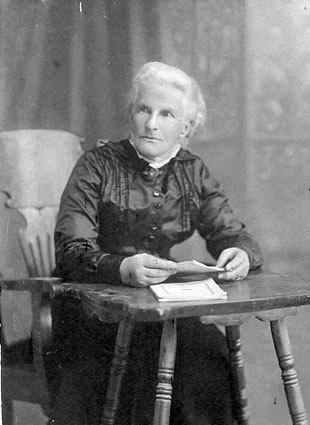
Biography contributed by Joanna Lewin (great-great-granddaughter)
Virginia Mary Pearce (nee Sly) was born 4 December 1852 in Hobart, Tasmania, Australia. She was the fifth child of Sarah Jane and James Sly.
The story of how Virginia’s family came to be in Tasmania is interesting, though perhaps not unusual for its time. Virginia’s maternal grandmother, Caroline Fitzallen, was a female convict who was sentenced to transportation for life in 1826 for stealing a £50 note from her employer in London. Virginia’s mother, Sarah Jane, travelled with her mother Caroline to Tasmania on the female convict ship Persian as a five year old, arriving in their new land in August 1827.
Virginia’s father, James Sly, came to Tasmania from Ireland as a free settler in 1840. He took advantage of the opportunities provided by the new colony and established himself as a successful businessman who imported boots and shoes. He was a well-respected member of the Hobart community and was an elected a member of the City Council, where he was at the forefront of many reforms, particularly the abolition of transportation, and the bringing about of the Constitution.
Sarah Jane Fitzallen and James Sly married in 1843 in Hobart, and went on to have 11 children, with four dying in infancy. In 1864, the family decided to leave their seemly comfortable middle-class life in Hobart and set sail for Dunedin. It was the height of the Otago gold rush, and James established himself as a bootmaker and importer. Little did they know that the decision to live next to Captain William Andrew Jarvey and his family in Caversham would place them at the scene of one of Dunedin’s most infamous murders. Both Sarah Jane and James, as well as their oldest son, William, became witnesses in the two trials of Captain Jarvey, the first man to be hanged at Dunedin Gaol for murdering his wife with rat poison. Sadly, Sarah Jane died while giving birth to her 12th child in July 1865, before the second trial finished.
Virginia was only 12 when her mother died and no doubt had to help look after her younger siblings while their father continued to move around Otago, establishing various boot making businesses. In 1878 the family were living on Palmerston, Otago, and it is here that Virginia met and married William John Pearce. William was the son of a convict who had also travelled from Tasmania to Dunedin as a child with his family, just like his wife. William was a butcher, a trade passed down from his father.
William and Virginia had their first two children in Waikouaiti, Otago, just south of Palmerston. They then moved back to Dunedin, where they had six more daughters, losing two in infancy. Two years later in 1893, at age 40, Virginia signed the Suffrage petition.
By 1895, the Pearce family had moved north to Christchurch, where William worked as a butcher for the Christchurch Meat Company. They had one last daughter, bringing the family total to one son and six daughters.
On 11 March 1899, William and Virginia were involved in the Rakaia railway accident. Two trains were carrying employees of the Christchurch Meat Company and their families, who had been on their annual picnic to Ashburton, and the second train ran into the rear of the first train at the Rakaia Railway Station. Four passengers were killed and 22 people were injured.
Virginia Pearce was not listed as one of the injured passengers aboard the trains. However, after the accident, Virginia and William sued the Crown for £2,000 and £1,500, respectively, for injuries sustained by Virginia in the accident. After hearing testimony from doctors and nurses, the Pearce’s were awarded £1,500 for Virginia, and £1,000 for William. This was a substantial sum, almost 20 times William’s annual salary at the time.
Sometime between 1900 and 1909, William and Virginia shifted north, all the way to Gisborne. It is unclear what precipitated this move – perhaps they had family living there, or William had been offered employment, or they sought warmer climes due to Virginia’s poor health.
It is difficult to know for sure just how unwell Virginia was, however. A photo of her in her later years shows a well-looking older woman, or at least one not bedridden. Indeed, Virginia lived a further 25 years after the railway accident, dying at age 71 on 23 September 1924. She left behind one son, James William Pearce, who fought in WWI and survived Gallipoli, and six strong daughters who all grew up with the right to vote, thanks to their mother and the other inspiring women who signed the Suffrage petition.
Sources
Ancestry.com.au https://www.ancestry.com.au
Female Convict Research Centre https://www.femaleconvicts.org.au/
The Old Bailey Proceedings Online, 1674-1913 https://www.oldbaileyonline.org/
Papers Past https://paperspast.natlib.govt.nz/
Image

Virginia Mary Pearce (nee Sly), source unknown.
Click on sheet number to see the 1893 petition sheet this signature appeared on. Digital copies of the sheets supplied by Archives New Zealand.

Community contributions